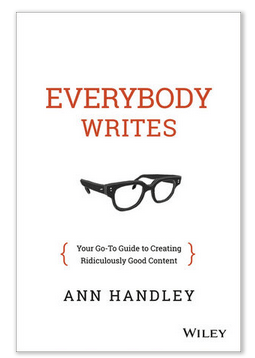 An Act-On Conversation
An Act-On Conversation
Editor’s Note: Ann Handley is the Chief Content Officer of MarketingProfs. She also writes a monthly column for Entrepreneur magazine, and co-author of the best-selling book on content marketing, Content Rules (Wiley, 2012), which has been translated into nine languages. Ann co-founded ClickZ.com, one of the first sources of interactive marketing news and commentary.
Atri Chatterjee is Act-On’s Chief Marketing Officer. This is an edited transcript of the Act-On Conversation they held, which you can listen to on the audio player below.
ATRI: Welcome, Ann. We’re thrilled to have you with us today to talk about one of the most significant issues for our customers: content marketing for small teams.
ANN: Thank you very much for having me. I’m really honored to be here.
ATRI: Content marketing has really become a driving force today, especially for business-to-business marketers. Small marketing teams have specific challenges; we’re going to address some of those challenges today.
In preparation for this, we at Act-On did a little poll of our customers to get an understanding of what their most pressing concerns with content marketing are. We collected that information and boiled it down to six or seven questions.
ANN: Let’s just jump right in.
Generate the right content
ATRI: The first question is: How can I generate enough new and interesting content? We got this from just about all we talked to. It seems like a daunting task for everyone.

ANN: I hear that a lot. Not just from small businesses or small marketing teams; this is a huge challenge for even bigger marketing teams. Nobody has enough time. Nobody has enough budget. So the first thing to remember is that this is a whole new way of doing marketing. It’s a different mindset, especially for marketers who are used to being in a campaign mindset. The mindset that you’re in now is much more focused on having a consistent program. Not just a one-and-done campaign, but a really consistent approach to how we’re doing marketing.
I know it’s a big challenge. But what I see often with not just small businesses, but also bigger companies, is that they try to do too much. [LAUGHTER] Just to start, you understand that you have a website, you’re a publisher, you may be on social media. The first thing is just to focus. Do one thing really, really well. And how do you know what that one thing is? Ask yourself: Where are your customers? How do they want to communicate with you? Essentially it means knowing who you are and what you’re capable of, and also knowing your customers, where you can talk to them and how you can reach them.
ATRI: So it’s really about focusing on one set of things that you want to do. Beginning with the things that are interesting to your customers, and narrowing that down to a starting point. And then over time more and more things will come up.
ANN: Yes. How can you help your customers? What questions do they have? I think the best place to look for content ideas is exactly what you just did for this podcast with me. Go to your customers and ask them, what questions do you have, what can we help you with? One of my favorite examples of this is a website called Crew. (It used to be called “oomph.”) They’re like a match.com for developers; they match developers with projects.
Through talking to their customers they found out that the biggest question their customers had was, “How much is it going to cost us to make an app?” Small company, strapped resources, small budget. They built a website called “How Much to Make an App?” which is an interactive tool that anybody can use. You can go on there and indicate whether you want to build an iPhone or Android app, whatever the case may be. It walks you through a series of questions and delivers a number that you can benchmark.
So that’s a really great example of how you can create something that’s really useful to the audience, that’s also wrapped up in your bigger story. You’re being very helpful to them. But at the same time, you’re driving leads. So I think that’s key, creating content that your customers want, and that tells your bigger story, that really positions you as the expert, and that ultimately brings them to you as that expert.
ATRI: I think perhaps one very interesting relevant measurement is that if it’s going to be useful to you, if you find something that you were really looking for as an answer to something, then there are probably many others who are looking for it. We definitely do that within Act-On, in our own marketing department here. If something works for us in the marketing department, then it’s probably going to work for a few others, and that serves as a good basis for coming up with an interesting piece of content to share.
ANN: Exactly. And I like what’s inherent in that: to approach your marketing with a spirit of generosity. I talk to a lot of companies who are worried about sharing secrets. They say: Well, if we tell them how much it is to make an app, or if we give away our marketing secrets, doesn’t that mean that people aren’t going to buy from us? It’s that whole notion of Why buy the cow when you get the milk for free? But I think that’s the wrong attitude. I think you want to be generous with the people that you’re trying to reach. Because what you’re doing is demonstrating your own thought leadership, your own position.
And that’s really the opportunity of content marketing and social media: We can share and connect with our customers directly. So why not give them gifts, give them content gifts, is what I talk about quite often. Just as you were just describing.
The role of influencers in content marketing

ATRI: That’s really good advice. There are a couple of questions that came in that follow that particular thread.
One of them was, How do we get better conversations out of our content? People are concerned that they spend time and effort creating content; they want to try to get the most out of it, and they want to get people drawn into a conversation. And of course, the interesting thing with that is that you don’t know where it’s going to go. It may lead to a much richer experience than you originally thought. So what advice can you give to marketers about creating interesting content, but then try to get the most out of it by getting better conversations out of it?
ANN: That’s a really good point. I think one of the biggest things that every company should be doing, and again no matter what size you are, whether you’re a small company or big, is that everybody should have a list of influencers that they’re connecting with. What do I mean by that? I just mean people who are really known in their industry and have some sort of followers. Really make friends with them. There’s many different ways that you can do that. But the idea is to just connect with people who have a following that you want to reach.
Now obviously there’s an art to that. You can’t just go out and say, share this for me. In other words it becomes a relationship-building task first. Build relationships with these people, again – approach them with a spirit of generosity, give them gifts, highlight them, have them on your podcast (for example like this one). Anything that you can do to make them a hero as well. So give them gifts, and then in turn you’ll build relationships with them. Then they’ll want to share things for you.
Companies that have physical locations have the ability to host a party or some other sort of event for influencers, where they can invite them in and treat them like royalty in one way or another. And there are various tools that you can use to identify who your influencers are in your particular industry. GroupHigh is one that helps you get a list of relevant blogs, blogs that have some sort of following that you might want to be connected with. Little Bird is another tool that I’ve used in the past to connect with influencers in various industries.
Even Twitter search allows you to filter and find people who are talking about things that you can speak to. So if you’re looking to get more pickup on your content, connect with those influencers and get them on your side, and share it with them. I guarantee they’ll love to share really good quality content – because they’re looking for it too.
Content curation and content partners
ATRI: Right. This goes back to your earlier comment about being generous. The other part of generosity is to be a source of amplification for them also. More new content can come out that way. It doesn’t all have to be authored by you; someone else can author it and you can adapt it, which gives you leverage.
ANN: That’s a really good point. Sometimes you can share content that’s created by others. Another opportunity, especially for small businesses, is to identify people who are natural content creators, who are already creating content in your industry, and partner with them.
It always astounds me: No matter how niche you think your industry is, if you go on YouTube, if you go on Pinterest or whatever is relevant to your particular product or service, I guarantee you will find people who are as passionate about it as you are, who are probably already creating content. I’ve seen this time and time again. There are people out there who just are natural content creators. If you offered to sponsor them in some way, they would probably be thrilled to have somebody backing them.
I think there’s this mindset that oh, we have to always be the creator. Well – sometimes we don’t. There are various ways to kind of get at the issue.
ATRI: That was one of the other questions that we got: What’s the strategy for curation? Our customers are typically small marketing teams doing a variety of different things. We tell our customer base that marketing automation (for example) is not a part-time job for someone who’s also doing five other things. You need to have the discipline to spend on it. Similarly with content. But even with discipline, you’re not going to be able to create enough.
Do you have some sort of specific advice or rule of thumb that you can give to people about what’s the best curation strategy? What should they be thinking about?
ANN: It’s funny ’cause I sort of have a – I’m almost allergic to that phrase, “content curation.” Because it’s such a [LAUGHTER] –
ATRI: – It sounds very clinical.
ANN: It really does. It implies that there’s some sort of machinery involved, when actually I think the value in curation is very much about the human beings who are doing it. You could use a tool to curate, like Curata for example. Or you could use something like Google Alerts, just to deliver curated headlines you could consider. But I think the real value is, once you have that relevant content that you targeted through keywords, what you do with it. The value for businesses and for their audience is when you add that human element.
Imagine that you found a good article on, I don’t know, chicken coops [LAUGHTER], building a backyard chicken coop. Don’t just broadcast that to your audience, but tell me why it’s relevant. This is a great look at using reclaimed lumber to create a chicken coop, or something like that. That was a silly example. But you know what I’m saying.
ATRI: Yes, I do. It’s not that different from what my high school teacher used to say: You’ve got to have a point of view. So it seems an important part of curation to have a point of view so that you can comment or expand on something that’s already out there.
ANN: Exactly. Tell me why it matters and why you’re sharing it with me. When you add that human element to it, curation becomes really valuable to the audience that you’re trying to reach.
Just a couple of quick tips about curation generally. It’s great to rely on a variety of sources in your industry. So don’t just rely on just – in my example, buildingchickencoops.com [LAUGHTER]. Look to a number of examples, not just one source. Always credit that original source, which sounds really obvious, but I’m always surprised at the number of times that I see companies linking to secondary sources. That’s important.
And then make sure that you’re attributing it front and center. Don’t try to pass it off as your own, of course, or do that accidentally. Make sure that you’re really giving kudos to the original author or the original publication. It’s a great way to build relationships. (Ed. note: If you want to publish someone else’s article in toto, you need to do two things: 1. Get permission. 2. Use a canonical link in your page’s metadata so the search engines don’t perceive this as duplicate content. Learn how.)
ATRI: That’s good advice. Crediting the original source goes back to my college English classes [LAUGHTER] where you had to do the research to quote the actual original source, versus just quoting whatever you saw.
ANN: That’s important. And as you said too, having that context, having that point of view, making sure that you’re saying why you’re sharing something, and how you feel about it. That’s the value of it.
Take a look at Part 2 of “Ann Handley and Atri Chatterjee Talk: Content Marketing for the Small Team,” for the continued discussion!
In our content-driven world, you, me, and every marketer we know is, in fact, a writer. Preorder Ann’s new book (coming in September) – Everybody Writes: Your Guide to Ridiculously Good Content. This book is is a go-to guide to attracting and retaining customers through stellar online communication. September will be here before you know it! Get your content ready for Q4!

